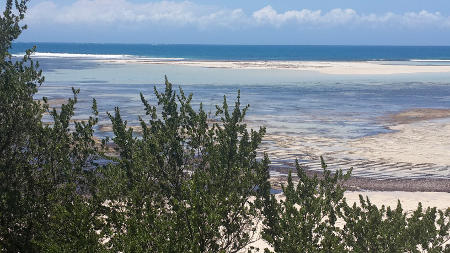
Off the famed Swahili coast are a number of sand-swept islands and
islets that provide the gorgeous, natural backdrop for so many adoring
"Swahili Style" coffee table books. You'd know Swahili
style if you saw it: rough-hewn furniture from dark woods like Moringa
and ebony, a touch of safari in the canvas accoutrements, bits of
colored glass, and a color scheme composed of whites, turqouise, and
dark, wooden colors. And if you're spending your days at the business
end of a computer in a modern, American office, the Swahili coast
really is a change in lifestyle that can repair a bruised soul.
If you've been living in Africa for a decade though, Swahili style
starts to seem a little put on, a little "created" a little
"invented for the tourists".
Continue reading "Bongoyo Island"

Since the age of sailing ships and spice routes, a Zanzibar chest has evoked treasure, mystery, and the legends of the East. They accompanied queens into exile and princes on conquest. A hard carved coffer plated with hammered metals, interior compartments and secret drawers, they were hard to make and harder to obtain. Their legends typically preceded them. The chests are still made today and typically hold dowries, spices, or family heirlooms. We returned to Zanzibar for Valentina, where in due form, it was hard to obtain and carry back home. But the reasons have changed over the centuries.
Continue reading "The Zanzibar Chest"
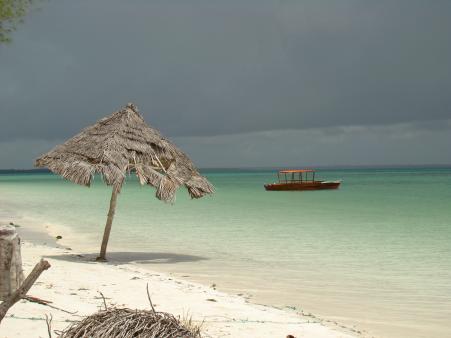
Zanzibar: even the name beckoned to me with bold strokes of an 18th century quill pen. At the cultural and geographical intersection of the African and Arabian worlds, Zanzibar is an island of turquoise waters reflecting the bright canvas sails of dhows, with forests full of birdsong, markets redolent of exotic spices, and a port town whose labrynthine alleyways whisper of Arabian Nights. But Zanzibar is equally a place of mystery and intrigue where even the dark eyed women go veiled. Everything about this spice island beckoned to me.
And so we went there to find out, and we were not disappointed. We found Omani palaces where the Sultan's concubines bathed in marble pools, mournful slave markets, aromatic spice bazaars, ornate cathedrals, and a thick-walled fortress that dates back to the Ottoman Empire. We also found beaches as white as porcelain, Colobus monkeys in the treetops, and a warm, pleasant people who never failed to tell us "karibu" ("welcome").
Continue reading "Zanzibar: Spice Island of Legend"
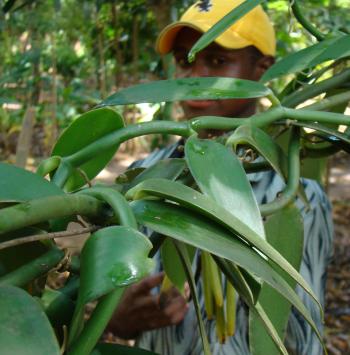
"You will tell me what this is," said Mohammed, our guide. "If you are right, I will congratulate you. If not I will tell you its name." But this time the question was easy: we were standing in front of a vanilla bean vine.
At the center of Zanzibar's east-meets-west allure is its spices, and even the local cuisine showcased the wealth and diversity of spices that are produced by the farmers in Zanzibar's fertile highlands.
We traveled up into the highlands to experience sensory overload firsthand. As we arrived, the glowering sky opened, soaking the soft earth in heavy drops and filling the air with the scent of flowers. The rain lasted only a few moments, and as the sun began to emerge from behind the clouds again the whole farm glistened like Christmas lights.
Continue reading "Cloudburst in the Garden of Earthly Delights"
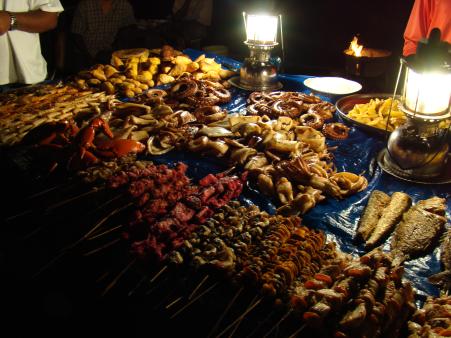
At Stone Town's waterfront, in the otherwise pleasant but unspectacular Forodhani Gardens, a masterpiece unfurled every evening as the sun plunged into the turquoise Zanzibar Strait. Evenings the Gardens host dozens of local artisans who set up broad tables and charcoal grills and cook all sorts of seafood delicacies in local sauces over the coals.
Zanzibar is renowned for its delicate and imaginative cooking. A hub of the spice trade for centuries, blessed with a diversity of seafood and tropical fruits, and at the nexus of both Middle Eastern and African cuisines, the result is a panoply of taste experiences as exotic and enticing as the island itself. And nowhere was this more evident than evenings in the Forodhani Gardens.
Continue reading "Feasting in the Forodhani Gardens"
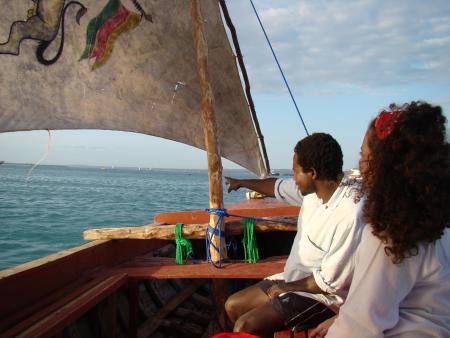
As we raced northward under the setting sun I watched the coast of Zanzibar pass by in the darkening evening. The mangrove estuary was now flooded with high tide and many of the ships we'd admired in dry dock now floated idly in the shallow water. We heeled over slightly in the stiff breeze, but the dhow trimmed nicely along the waterline. Issa adjusted the thick mainsheet incessantly, going for that very last bit of performance from his wooden craft. Out of habit, my eyes surveyed the bilge and the wooden keel, looking for pooling water. It was dry as a bone.
Continue reading "By Dhow Along the Zanzibar Coast"






